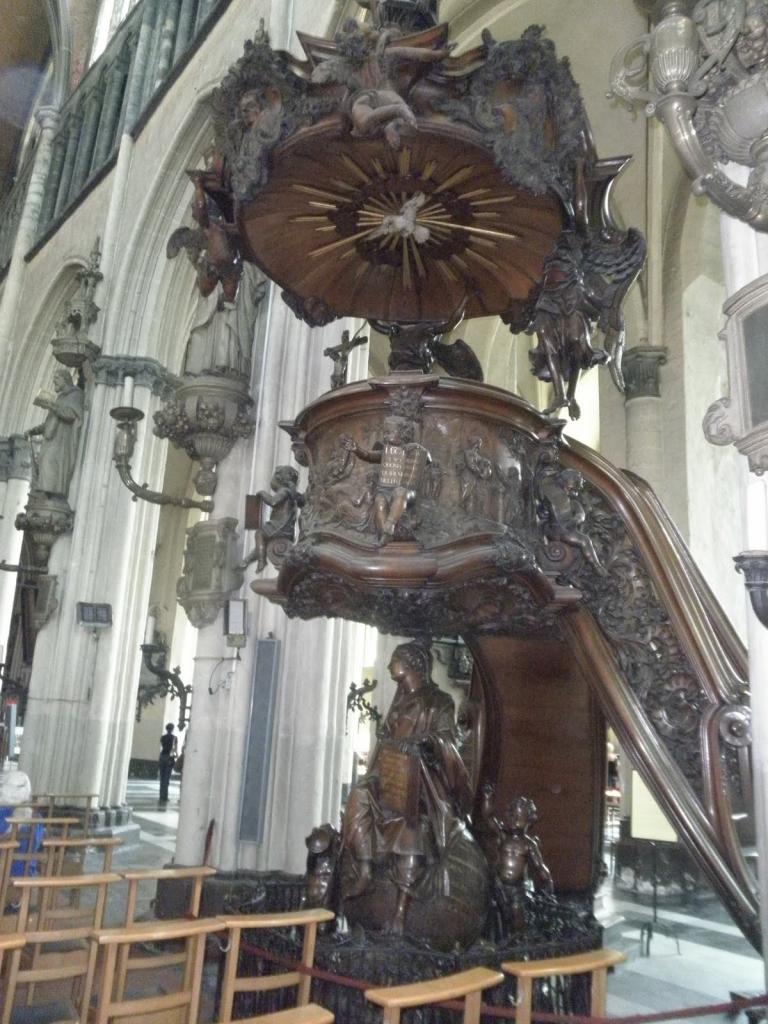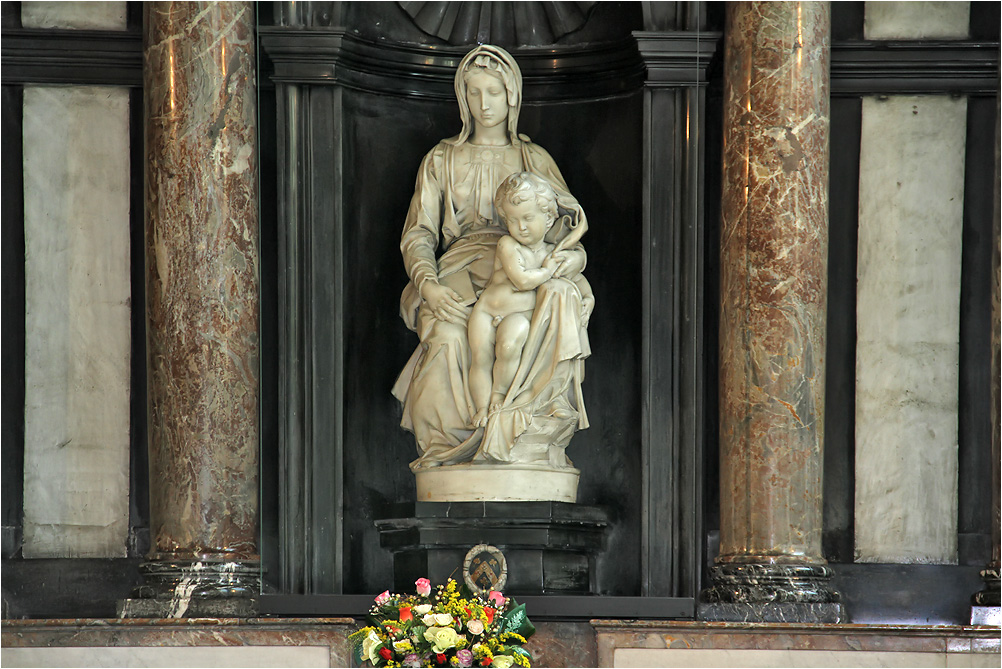The most beautiful Gothic church in Belgium is considered to be the active Catholic Church of Our Lady in Bruges, towering in the central part of the city. This is one of the earliest brick buildings in Flanders. Its tower - 115.6 meters - remains the highest structure of the city and the second highest brick tower in the world. In addition to believers, there are many tourists annually attracted by the beauty of medieval architecture and the beautiful creations contained in the Church of Our Lady.
Story
The church was founded by the Anglo-Saxon archbishop Saint Boniface, a zealous distributor of Christianity in the Flemish lands. In the 9th century, a chapel was built, which was run by the community of canons of St. Martin. The cathedral began in 1091, and after about ten years the construction of a new Romanesque church began. Its construction was financed by Count Charles I of Flanders, nicknamed the Good and, centuries after death, canonized. The great fire of 1116, which incinerated half of the city, also damaged the temple structure. Traces of the foundation of the first house of worship were found under the altar of the current Church of Our Lady during archaeological research in 1979.
Even before the fire, the temple began to acquire significant Christian relics, some of which were donated with the active participation of Bishop Godebald from Utrecht, the religious center of the Netherlands. One of these rarities was the relics of St. Boniface, the bishop of Mainz, who was killed in 754 and the relics of his companions. The remains were stored in tin cancer, at the beginning of the XVII century a silver ark was made for them, where the relics were solemnly transferred and where they remain in the Church of Our Lady today.
The construction of the current church began in the XIII century, and over the long time of its existence, the church was not subjected to major damage. The most damage was caused by atrocities and robberies in the 16th century by the iconoclasts, the French occupiers after the revolution of 1789, the German occupiers during the Second World War, and also by the hurricane of 1711 when the wind tore off the cross and drains from the main tower. In 1789, parishioners bought the church building, which, due to events related to the French Revolution, was put under the hammer.
Architecture
A two-story longitudinal main nave was built between 1210 and 1230. This is the period when the features of Gothic architecture from France actively began to penetrate into Flanders, and the central nave corresponds to the Flemish style Sheldegotik, combining Romanesque and Gothic architecture. The second phase of construction continued from approximately 1280 to 1335. At that time, two filigree stair towers were erected on the western facade (1280), a transept (transverse nave), a choir (altar part of the building), and in 1320 the construction of the mighty North Tower, which dominates the urban landscape today, ended. The construction reached 122.3 meters, and the construction of the 45-meter spire was completed 20 years later.
In 1345, the second northern nave was added to the central one, and from 1450 to 1474 its southern counterpart was built. These two outer naves of the five-step complex, together with the later Paradise Gates at the base of the tower, represent the Gothic style of Brabant, a province in northern France whose architecture had a significant impact on Flemish medieval construction. In 1480, the sacristy and chapel were completed. The whole complex looks elegant, romantic and majestic, as can be judged by the numerous photos of the Church of Our Lady in Bruges.
Interior
If the appearance of the Church of Our Lady delights, then its inner space makes an even stronger impression. The laying of red brick vaults creates a harmonious contrast with the stone elements. Elegant colonnades with lancet apertures reproduce the shape of high windows. But more striking is the wealth of wooden carved, pictorial, sculptural works of sacred art collected in this temple for different time periods. Here are the masterpieces of the painters Van Ostade, Zegers, de Cryer, Quellina. One of the paintings "Crucifixion" allegedly belongs to the brush of Van Dyck.

The two meter tall marble statues of the Twelve Apostles rise on the columns of the central nave. They seem to accompany the parishioners from the entrance to the main altar, on which the majestic crucifixion of the work of 1594 is exalted. It hovers over the worshipers and ascends to lancet brick vaults. The wooden pulpit is decorated with delightful carvings, and its main composition in the form of a female figure sitting on a globe symbolizes the Christian faith that encompasses the whole world.
Special Attractions
Two magnificent sarcophagi - Karl the Bold, the last Duke of the Burgundian family of Valois and his daughter Maria of Burgundy, are kept in the church parish with special respect, as evidenced by their location - in the choir space, under the crucifix behind the central altar. Each coffin is made of black marble and decorated with bronze heraldic ornaments. The polished lids of the sarcophagi are filled with the figures of the deceased, skillfully displayed in gilded bronze, crowned, in full ceremonial vestments, decorated with orders of the Golden Fleece.
Like many European churches, under the marble slabs of the Church of Our Lady, the remains of some venerable parishioners are buried. Several empty 14th-century chambers made of masonry or brickwork are displayed for inspection under glass display cases. On their plastered walls you can see well-preserved sacred images.
A special event for the church was the year 1468. Here passed the II chapter of the influential and powerful Order of the Golden Fleece, which was honored by the presence of the English king Edward IV, whose coat of arms was placed above the column at the choirs. The arms of thirty knights, members of the chapter, are above the benches.
The altar of the large chapel in the southern gallery contains the main, spiritually and artistically, treasure of the church - the snow-white marble statue of the Virgin Mary with the baby of the work of the genius Michelangelo.
Madonna of Bruges
The Church of Our Lady in Bruges received this statue in 1504 thanks to two townspeople, wealthy textile merchants, brothers Jan and Alexander Muskron, who bought the work for 4000 florins. This is the only sculpture of Michelangelo that left Italy during the life of the great sculptor. The work is significantly different from other early works of the sculptor of the same subject. Instead of a pious young maiden smiling at the baby in her arms, Michelangelo portrayed Mary weakly holding her son with her left hand and looking down to his right. Her face embodies tenderness and sadness, as if the mother knew the sacrificial fate of her child. Jesus stands upright, almost not supported by Mary, and as if about to leave her.

Probably, the composition was created for the altar, but it does not meet many of the requirements of church canons. The Madonna and Child shares some resemblance to Michelangelo's Pieta, a sculpture of Marie mourning Christ, which was completed shortly before. The generality is noticeable in the effects of chiaroscuro and the marble folds of drapery, but mainly the similarity is seen in Maria’s elongated oval face with an expression of humble sadness, which also resembles Pietu. The sculpture produces a strong psychological impact even on people who are indifferent to religion, and among believers, they say, it causes true awe.